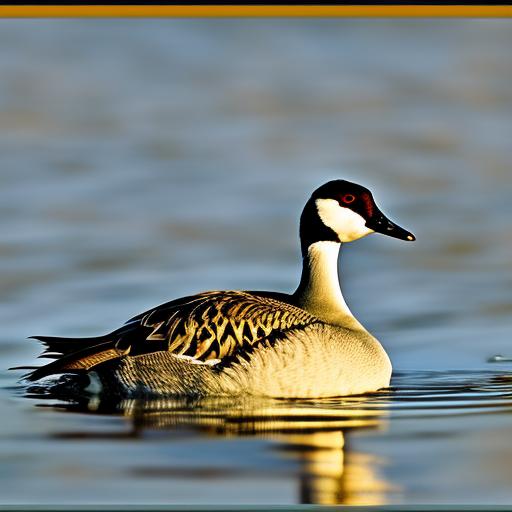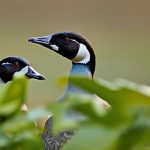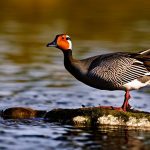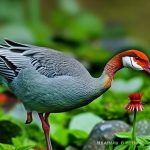Canadian geese infestation is a growing problem in many areas, causing damage to property and posing health risks. Finding humane solutions to keep them away is crucial in order to protect both the geese and the environment. This article will explore various methods and strategies to deter Canadian geese from infesting certain areas, focusing on natural deterrents, physical barriers, sound and visual deterrents, repellents, water source management, adopting humane methods, seeking professional help, maintaining a clean environment, and educating others on prevention.
Key Takeaways
- Canadian geese are highly territorial and will aggressively defend their nesting sites and young.
- Natural deterrents such as planting tall grasses and using decoys can discourage geese from settling in an area.
- Physical barriers like fences and netting can prevent geese from accessing certain areas.
- Sound and visual deterrents like loud noises and flashing lights can startle geese and make them uncomfortable.
- Repellents like taste aversion sprays and predator urine can discourage geese from returning to an area.
Understanding Canadian Geese Behavior
Canadian geese are large waterfowl that are native to North America. They are known for their distinctive honking sound and their V-shaped flying formation. These geese are attracted to areas with open water, lush grass, and ample food sources. They are social animals that prefer to live in large groups and are highly adaptable to different environments.
The behavior of Canadian geese plays a significant role in their infestation. They are known to be territorial and will aggressively defend their nesting sites. They also have a strong homing instinct and will return to the same location year after year. Additionally, they have a high reproductive rate, with each pair of geese producing an average of 4-6 goslings per year. This combination of territorial behavior, homing instinct, and high reproductive rate contributes to the rapid growth of geese populations in certain areas.
Natural Deterrents for Canadian Geese
One effective way to deter Canadian geese is by using natural deterrents. Certain plants and landscaping features can repel geese by making the area less attractive to them. For example, planting tall grasses or shrubs near bodies of water can create a barrier that discourages geese from landing or nesting. Additionally, using plants that geese do not like to eat, such as prickly bushes or plants with strong odors, can also deter them.
Another natural deterrent for Canadian geese is the presence of natural predators. Geese are wary of predators such as coyotes, foxes, and dogs. By allowing these predators to roam freely in the area, geese will be less likely to stay or nest there. However, it is important to note that using predators as a deterrent should be done in a humane and responsible manner.
Creating a natural habitat that discourages geese is another effective method. This can be achieved by maintaining a healthy ecosystem with diverse plant and animal species. By providing a balanced environment, geese will be less likely to dominate the area and will seek out more suitable habitats.
Creating a Physical Barrier to Keep Canadian Geese Away
Physical barriers are another effective method to keep Canadian geese away. There are various types of physical barriers that work well, such as fences, netting, and hazing devices. Fences can be installed around bodies of water or areas where geese tend to congregate, preventing them from accessing these areas. Netting can be used to cover specific areas, such as lawns or gardens, to prevent geese from landing or grazing.
Installing and maintaining physical barriers requires careful planning and regular maintenance. Fences should be tall enough to prevent geese from flying over them and should be securely anchored to the ground. Netting should be properly installed and regularly checked for any damage or gaps. Hazing devices, such as motion-activated sprinklers or noise-making devices, can also be effective in deterring geese by creating a sense of danger or discomfort.
While physical barriers can be highly effective in keeping geese away, they do have some drawbacks. They can be expensive to install and maintain, especially for larger areas. Additionally, they may not be aesthetically pleasing and can disrupt the natural flow of the environment. Careful consideration should be given to the specific needs and requirements of the area before implementing physical barriers.
Utilizing Sound and Visual Deterrents
Sound and visual deterrents can also be effective in deterring Canadian geese. These deterrents work by creating a sense of danger or discomfort for the geese, making them less likely to stay or nest in the area. Some examples of sound deterrents include loud noises, such as air horns or bird distress calls, and predator calls, such as recordings of coyotes or dogs. Visual deterrents can include scarecrows, reflective tape, or decoy predators.
Using sound and visual deterrents effectively requires careful placement and regular maintenance. Deterrents should be strategically placed in areas where geese tend to congregate or nest. They should also be regularly moved or changed to prevent geese from becoming accustomed to them. It is important to note that sound and visual deterrents should be used in a responsible and humane manner, without causing harm or distress to the geese.
While sound and visual deterrents can be effective, they do have some limitations. Geese may become habituated to certain deterrents over time, rendering them less effective. Additionally, these deterrents may not work well in areas with high levels of noise or activity, as the geese may become accustomed to the sounds or visuals. Careful consideration should be given to the specific needs and requirements of the area before implementing sound and visual deterrents.
Implementing Repellents to Discourage Canadian Geese

Repellents can also be used to discourage Canadian geese from infesting certain areas. There are various types of repellents that work well, such as taste repellents and chemical repellents. Taste repellents are applied to grass or other vegetation and make it unpalatable for geese to eat. Chemical repellents work by emitting an odor that is unpleasant for geese.
Using repellents effectively requires careful application and regular maintenance. Taste repellents should be applied to grass or other vegetation according to the manufacturer’s instructions. Chemical repellents should be applied in areas where geese tend to congregate or nest. It is important to note that repellents should be used in a responsible and humane manner, without causing harm or distress to the geese.
While repellents can be effective, they do have some limitations. Geese may become habituated to certain repellents over time, rendering them less effective. Additionally, some repellents may have negative effects on other wildlife or the environment. Careful consideration should be given to the specific needs and requirements of the area before implementing repellents.
Properly Managing Water Sources to Prevent Geese Infestation
Water sources are a major attractant for Canadian geese, as they provide both food and shelter. Properly managing water sources can help discourage geese from infesting certain areas. One effective method is to modify the shoreline of bodies of water by creating steep slopes or installing rocks or gravel. This makes it difficult for geese to access the water and reduces their ability to graze on nearby vegetation.
Another method is to use floating barriers or islands in bodies of water. These barriers create a physical barrier that prevents geese from accessing certain areas. They can be made from materials such as netting or plastic and should be regularly maintained to prevent damage or deterioration.
Properly managing water sources also involves regular maintenance and cleaning. Removing excess vegetation, debris, and algae from bodies of water can help reduce the attractiveness of the area to geese. It is important to note that water source management should be done in a responsible and environmentally friendly manner, without causing harm to other wildlife or the ecosystem.
Adopting Humane Methods to Keep Canadian Geese at Bay
It is important to use humane methods when deterring Canadian geese in order to protect both the geese and the environment. Humane methods focus on creating an environment that is unattractive to geese and discourages them from staying or nesting in the area. Examples of humane methods include using natural deterrents, physical barriers, sound and visual deterrents, repellents, water source management, and maintaining a clean environment.
Implementing humane methods effectively requires careful planning and regular maintenance. Each method should be tailored to the specific needs and requirements of the area. It is important to consider the impact of each method on the geese, other wildlife, and the environment. Additionally, it is important to regularly monitor and evaluate the effectiveness of each method and make adjustments as needed.
Seeking Professional Help for Geese Control
In some cases, it may be necessary to seek professional help for geese control. This is especially true for larger areas or areas with a high population of geese. Professional help can provide expertise and resources that may not be available to individuals or small organizations.
When seeking professional help, it is important to find a reputable professional with experience in geese control. This can be done by asking for recommendations from local wildlife agencies or other organizations that deal with wildlife management. It is also important to ask for references and check the credentials of any professional before hiring them.
While seeking professional help can be effective, it does have some drawbacks. It can be expensive, especially for larger areas or ongoing maintenance. Additionally, it may not be feasible in all situations, especially in remote or rural areas where professional help may not be readily available. Careful consideration should be given to the specific needs and requirements of the area before seeking professional help.
Maintaining a Clean and Unattractive Environment for Geese
Maintaining a clean environment is crucial in preventing Canadian geese infestation. Geese are attracted to areas with abundant food sources, such as grass or other vegetation. By regularly removing excess vegetation, debris, and garbage from the area, geese will be less likely to stay or nest there.
Regular maintenance also involves keeping lawns and gardens well-maintained and free of excess water. Geese are attracted to areas with lush grass and standing water, so it is important to keep these areas dry and well-maintained. Additionally, it is important to regularly clean up any spills or food sources that may attract geese.
Maintaining a clean environment also involves educating others on the importance of cleanliness and proper waste disposal. By encouraging others to take responsibility for their own waste and to keep the environment clean, geese infestation can be prevented.
Educating Others on How to Prevent Canadian Geese Encroachment
Educating others on how to prevent Canadian geese encroachment is crucial in preventing infestation. By raising awareness and providing information on the importance of humane methods and responsible environmental practices, individuals and communities can take action to prevent geese infestation.
Effective education involves providing clear and concise information on the behavior of Canadian geese, the impact of infestation, and the various methods available for prevention. This can be done through workshops, seminars, or educational materials such as brochures or websites. It is important to tailor the information to the specific needs and requirements of the audience.
While educating others can be effective, it does have some limitations. Not everyone may be receptive to the information or willing to take action. Additionally, education alone may not be enough to prevent geese infestation in certain areas. It is important to combine education with other methods and strategies for maximum effectiveness.
In conclusion, finding humane solutions to prevent Canadian geese infestation is crucial in order to protect both the geese and the environment. Understanding Canadian geese behavior, utilizing natural deterrents, creating physical barriers, using sound and visual deterrents, implementing repellents, properly managing water sources, adopting humane methods, seeking professional help, maintaining a clean environment, and educating others are all effective methods for preventing geese infestation. By taking action and implementing these methods, individuals and communities can successfully deter Canadian geese and create a safe and healthy environment for all.
If you’re looking for effective ways to keep Canadian geese away, you might also be interested in learning about the benefits of a SnapLock chicken coop. This innovative coop design from Poultry Wizard provides a secure and predator-proof environment for your chickens, ensuring their safety while also deterring unwanted visitors like geese. To find out more about this practical solution, check out the article on poultrywizard.com.
FAQs
What are Canadian geese?
Canadian geese are a species of waterfowl that are native to North America. They are known for their distinctive black heads and necks, white cheeks, and brown bodies.
Why do Canadian geese need to be kept away?
Canadian geese can cause damage to property, create health hazards, and be a nuisance to people. They can also be aggressive and territorial, especially during nesting season.
What are some methods for keeping Canadian geese away?
Some methods for keeping Canadian geese away include using visual deterrents, such as scarecrows or reflective tape, using noise deterrents, such as loud noises or predator calls, and using physical barriers, such as fencing or netting.
Are there any natural ways to keep Canadian geese away?
Yes, there are natural ways to keep Canadian geese away, such as planting tall grasses or shrubs to create an unappealing habitat, using dogs to chase them away, or introducing natural predators, such as foxes or coyotes.
Is it legal to harm or kill Canadian geese?
No, it is illegal to harm or kill Canadian geese without a permit. Canadian geese are protected under the Migratory Bird Treaty Act, which prohibits the hunting, killing, or possession of migratory birds without a permit.
Meet Walter, the feathered-friend fanatic of Florida! Nestled in the sunshine state, Walter struts through life with his feathered companions, clucking his way to happiness. With a coop that’s fancier than a five-star hotel, he’s the Don Juan of the chicken world. When he’s not teaching his hens to do the cha-cha, you’ll find him in a heated debate with his prized rooster, Sir Clucks-a-Lot. Walter’s poultry passion is no yolk; he’s the sunny-side-up guy you never knew you needed in your flock of friends!







